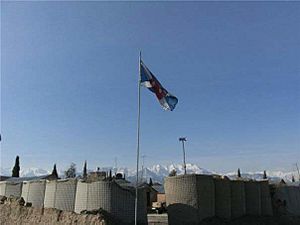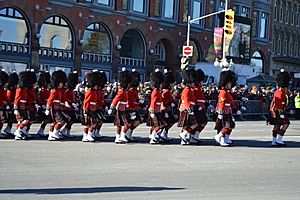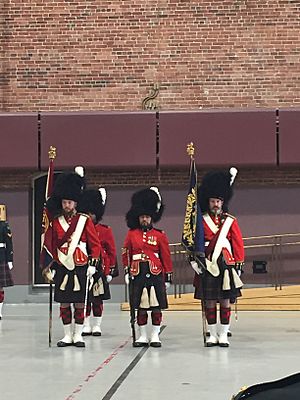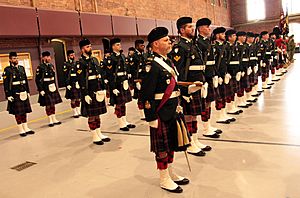The Cameron Highlanders of Ottawa (Duke of Edinburgh's Own) facts for kids
Quick facts for kids The Cameron Highlanders of Ottawa (Duke of Edinburgh's Own) |
|
|---|---|
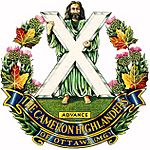
Badge of the Cameron Highlanders of Ottawa
|
|
| Active | 1881–present |
| Country | |
| Branch | Canadian Army |
| Type | Infantry |
| Role | Light infantry |
| Size | 300+(Battalion) |
| Part of | 33 Canadian Brigade Group |
| Garrison/HQ | Ottawa |
| Nickname(s) | Camerons |
| Motto(s) | Advance |
| March | "The March of the Cameron Men" and "Piobearached o' Donald Dubh" |
| Battle honours |
|
| Commanders | |
| Current commander | Lieutenant-Colonel Gord Scharf, CD |
| Regimental Sergeant Major | Chief Warrant Officer Drummond Robinson, CD |
| Honourary Colonel of the Regiment | Honourary Colonel Dan MacKay, CD |
| Honourary Lieutenant-Colonel of the Regiment | Hon Lieutenant-Colonel Barbara Farber |
| Insignia | |
| Tartan | Cameron of Erracht |
The Cameron Highlanders of Ottawa (Duke of Edinburgh's Own) is a special group of soldiers in the Canadian Army. They are a Primary Reserve infantry regiment, which means they are part-time soldiers who train regularly and can be called upon to serve when needed. They are known as the "Camerons" for short.
Contents
- History of the Camerons
- Regimental Identity and Dress
- Regimental Structure and Training
- Helping at Home
- Battle Honours
- Victoria Cross Recipients
- Regimental Connections
- Honored History
- Freedom of the City
- Cartier Square Drill Hall
- The Cameron Highlanders of Ottawa Museum
- Music
- Media
- Order of Precedence
History of the Camerons
Early Beginnings
The story of the Camerons began on April 3, 1856. Back then, they were called the 1st Volunteer Militia Rifle Company of Ottawa. Canada's military was made up of many small, independent groups.
In 1866, a larger group called the 43rd Battalion of Infantry was formed. It was also known as the Carleton Blazers. This battalion included the Ottawa volunteer rifle company. This original company is still part of the Camerons today!
Defending Canada
The 43rd Battalion was first called to action in 1870. They went to the Prescott area to help protect Canada from attacks by a group called the Fenians. They didn't have to fight there and soon returned home.
Because the soldiers were spread out, it was hard to keep the group strong. So, in 1875, the regiment was temporarily stopped.
In 1881, the unit was started up again. This time, it was called the 43rd "Ottawa and Carleton" Battalion of Rifles. It included the Ottawa volunteer rifle company and other groups from towns near the Ottawa River.
Boer War and Royal Connections
Over the next 20 years, soldiers from the 43rd Battalion helped in conflicts like the North-West Rebellion and the Second Boer War. However, the whole battalion didn't go. Instead, individual soldiers volunteered to join other units.
During the Boer War, a soldier named Private R.R. Thompson showed great bravery. He saved wounded soldiers and was awarded a special scarf called a Queen's Scarf. These scarves were crocheted by Queen Victoria herself!
In 1902, the Duke of Cornwall, who later became King George V, was very impressed by the regiment. He became their first honorary colonel. This allowed the regiment to use his name. They were then known as the 43rd Regiment, Duke of Cornwall's Own Rifles.
World War I Efforts
When World War I started in 1914, the unit was ready to help. But like before, the entire unit didn't go overseas together. Instead, they focused on finding and training new soldiers. These soldiers mostly joined the 2nd, 38th, and 207th battalions of the Canadian Expeditionary Force.
The Camerons still remember and honor the history of the 38th and 207th battalions. The 38th Battalion fought bravely in France from 1916 to 1918 and earned many awards. The 207th Battalion went to France in 1917 and served as a backup force for other units.
Between the World Wars
Between the two World Wars, the 43rd Regiment changed its name a few times. In 1920, it became a highland regiment and was called The Ottawa Regiment (The Duke of Cornwall's Own).
In 1922, it was renamed The Ottawa Highlanders. Then, in 1933, it became The Cameron Highlanders of Ottawa. In 1936, "(M.G.)" was added to their name, meaning they used machine guns. Since 1881, the unit has used the motto "Advance," which is also the motto of the City of Ottawa.
World War II Heroes
In July 1940, the Cameron Highlanders of Ottawa's active battalion went to Iceland for guard duty. In April 1941, they sailed to England.
On June 6, 1944, the Camerons were the only unit from Ottawa to land on D-Day at Juno Beach. This was a very important day in World War II. Their 1st Battalion had three machine gun companies and one mortar company.
After D-Day, the battalion fought in almost every major battle in northwestern Europe. Soldiers from the battalion often joined other units to help them. While this meant they didn't always fight as one big group, their soldiers were crucial in many battles. Meanwhile, a 2nd Battalion in Canada trained new soldiers for overseas duty.
Modern Missions
Since World War II, the regiment has stayed in Ottawa. They are now a light infantry regiment, which means they are trained to move quickly and fight in different environments.
Since 1985, soldiers from the Camerons have served in NATO and United Nations missions around the world. They have helped with peacekeeping operations in places like Bosnia, Kosovo, The Congo, Cyprus, and Afghanistan.
During the war in Afghanistan, many Camerons volunteered to join the regular army. They helped with various tasks, from fighting in battles like Operation Medusa to training the Afghan National Army. They also helped with things like working with local communities and protecting bases. The regiment encourages its members to volunteer for missions overseas, so many Camerons have served abroad in recent years.
In August 2013, the Camerons were given the extra title Duke of Edinburgh's Own. This was because Prince Philip, Duke of Edinburgh, was their colonel-in-chief from 1967 until he passed away in 2021.
Regimental Identity and Dress
The 43rd Ottawa and Carleton Battalion of Rifles was first allowed to use the motto "Advance" in 1882. This motto has been used by all groups that followed, including the regiment today. It is also the motto of the City of Ottawa. The Camerons are proudly known as Ottawa's regiment and have the special honor called the freedom of the city of Ottawa.
The regimental badge shows the figure of St Andrew with a cross, surrounded by thistles and maple leaves. At the bottom, it says "ADVANCE" and "THE CAMERON HIGHLANDERS OF OTTAWA (M.G.)".
When a new soldier joins the regiment, they receive their Balmoral bonnet (a type of hat) and their Camerons cap badge. After they complete their infantry training, they get a blue feather called a hackle. This hackle sits on their cap badge.
As a Highland regiment, the Camerons wear a special dress uniform similar to other Canadian-Scottish regiments. They wear traditional Scottish kilts with a pattern called the Cameron of Erracht. Their green Canadian Forces jacket is cut in a way that goes well with the kilt.
Besides the kilt, soldiers wear a leather sporran (a small pouch worn in front of the kilt) and special shoes with Lovat hose (long socks) and red garter flashes. For more formal events, they wear white spats (covers for shoes), a white sporran, and a white belt. The regiment also has traditional red jackets called doublets and feather bonnets. These are worn for special ceremonies like guard duties and the annual Remembrance Day parade.
Regimental Structure and Training

The regiment has about 265 officers and soldiers. It is organized into different parts:
- Headquarters and Service Company: This is where the main offices are, including the Regimental Headquarters and the Pipes and Drums band.
- A Company: This company has a headquarters and four rifle platoons, which are groups of soldiers trained for combat.
- B Company: This company focuses on training. They prepare soldiers for leadership courses and basic military training.
- 33 Influence Activities Company: This special company helps the Canadian Armed Forces with "Influence Activities." This means they train people for things like Civil-Military Cooperation (working with civilians) and Psychological Operations (using communication to influence people). They make sure their team is ready to support Canadian missions anywhere.
Training for Soldiers
The main goal of the regiment is to find, train, and prepare infantry soldiers for missions both in Canada and overseas. To do this, they train every Thursday night from September to June.
Their training includes basic soldier skills, individual combat tasks, and advanced infantry tactics for small groups of soldiers. They also practice in the field, usually once a month, at places like CFB Petawawa or Connaught Ranges.
During the summer, soldiers attend longer training courses across the country. These courses help them gain the skills and qualifications needed to move up in rank.
In 2019, the regiment was given a special task: to train a Close Reconnaissance Platoon. This group is designed to gather information and scout ahead for other units.
Helping at Home
Camerons have also helped a lot with emergencies in Canada.
They were part of the relief efforts during the January 1998 North American ice storm. They helped people in and around Maxville, Ontario.
The regiment also helped with flood relief in the Ottawa-Gatineau area in 2017 and in Ottawa and Constance Bay in 2019.
Battle Honours
The regiment has earned 38 Battle Honours, which are special awards for bravery in battles. Twenty of these are proudly displayed on the Regimental Colour (their flag).
Africa
World War I
- Mount Sorrel
- SOMME 1916
- Ancre
- Ancre Heights
- ARRAS 1917, ‘18
- VIMY 1917
- YPRES, 1917
- PASSCHENDAELE
- AMIENS
- Scarpe 1918
- DROCQUORT-QUĖANT
- HINDENBURG LINE
- CANAL DU NORD
- VALENCIENNES
- Sambre
- France and Flanders 1916-18
World War II
- NORMANDY LANDING
- CAEN
- CARPIQUET
- The Orne
- BOURGUĖBUS RIDGE
- Faubourg de Vaucelles
- FALAISE
- Quesnay Wood
- The Liaison
- BOULOGNE 1944
- THE SCHELDT
- Breskens Pocket
- The Rhineland
- Waal Flats
- THE HOCHWALD
- THE RHINE
- Zutphen
- Deventer
- Leer
- NORTH-WEST EUROPE 1944-1945
Afghanistan
Victoria Cross Recipients
The Victoria Cross (VC) is the highest award for bravery in the British and Commonwealth armed forces. Two soldiers connected to the Camerons have received this honor.
Claude Patrick Joseph Nunney
Claude Nunney was a private in the 38th (Ottawa) Battalion during World War I. This battalion's history is carried on by the Cameron Highlanders of Ottawa. He earned the VC for his incredible bravery on September 1 and 2, 1918.
On September 1, when his battalion was preparing to advance, the enemy attacked heavily. Private Nunney, even though he was at headquarters, bravely went through the enemy fire to the front lines. He went from soldier to soldier, encouraging them with his fearless example. His actions helped save a difficult situation.
On September 2, during an attack, he was always ahead of his comrades. His bravery helped his company reach their goals.
Private Nunney died at age 25, 16 days after being seriously wounded. He is buried in France.
Thain Wendell MacDowell
Thain Wendell MacDowell was one of four soldiers to earn the Victoria Cross at the Battle of Vimy Ridge.
On April 9, 1917, at Vimy Ridge in France, Captain MacDowell, with the help of two assistants, reached the German position before his company. He destroyed one machine-gun nest and chased the crew from another.
Then, Captain MacDowell saw a German soldier go into a tunnel. At the bottom of the tunnel, he tricked the Germans into thinking he was part of a much larger force. This led to two German officers and 75 German soldiers surrendering! He sent the prisoners out of the tunnel in groups to be taken back to the Canadian lines.
Even though he was wounded in the hand, Captain MacDowell held the position for five days under heavy enemy fire until his battalion relieved him. He was promoted to Major for his actions at Vimy Ridge.
Regimental Connections
The Cameron Highlanders of Ottawa have a special connection with another military unit:
 United Kingdom – The Highlanders, 4th Battalion, Royal Regiment of Scotland (4 SCOTS). This British infantry battalion carries on the history of the Queen's Own Cameron Highlanders, a former Scottish regiment.
United Kingdom – The Highlanders, 4th Battalion, Royal Regiment of Scotland (4 SCOTS). This British infantry battalion carries on the history of the Queen's Own Cameron Highlanders, a former Scottish regiment.
Honored History
The Camerons also keep alive the history of these past units:
- 38th Battalion (Ottawa), CEF
- 43rd Battalion (Cameron Highlanders of Canada), CEF
Freedom of the City
The regiment has been given the special "freedom of the city" honor by several places:
 May 24, 1969: Ottawa, Canada.
May 24, 1969: Ottawa, Canada. May 8, 2019: Vis-en-Artois, France.
May 8, 2019: Vis-en-Artois, France.
Cartier Square Drill Hall
| Site | Date(s) | Designated | Location | Description | Image |
|---|---|---|---|---|---|
| Cartier Square Drill Hall | 1879 | Classified - 1985 Register of the Government of Canada Heritage Buildings | Ottawa, Ontario | This large building with a low roof is home to The Cameron Highlanders of Ottawa and The Governor General's Foot Guards. | 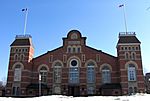 |
The Cameron Highlanders of Ottawa Museum
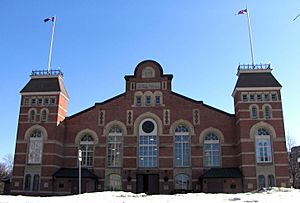 |
|
| Location | Cartier Square Drill Hall, Ottawa, ON K1A 0K2 Canada |
|---|---|
| Type | Regimental Museum |
The museum helps teach about the regiment's history. It collects documents, pictures, books, and military items. It focuses on the history of the Ottawa and Carleton Rifles, the Duke of Cornwall's Own Rifles, and the 38th and 207th Battalions from World War I. The museum also shows the uniforms, weapons, and traditions of the regiment's military past.
Music
- Canada: Far & Away (audio CD) by Cameron Highlanders of Ottawa Pipes & Drums and other Canadian Forces bands (2009).
Media
- The History of the 1st Battalion Cameron Highlanders of Ottawa (MG) by Lieutenant Colonel Richard M. Ross (1946).
Order of Precedence
| Preceded by Le Régiment de Maisonneuve |
The Cameron Highlanders of Ottawa (Duke of Edinburgh's Own) | Succeeded by The Royal Winnipeg Rifles |



